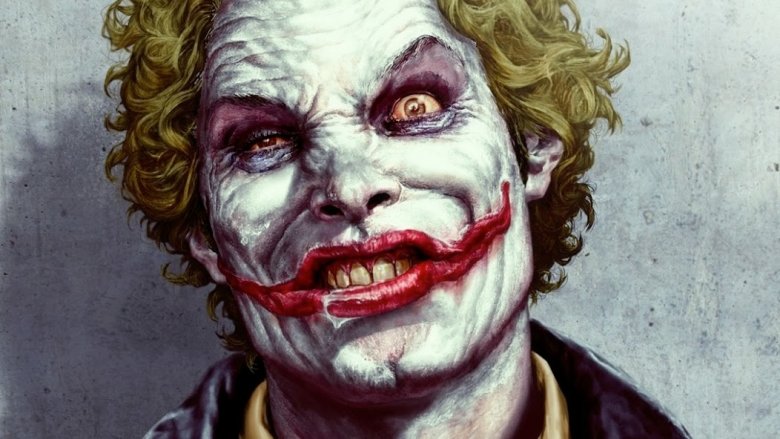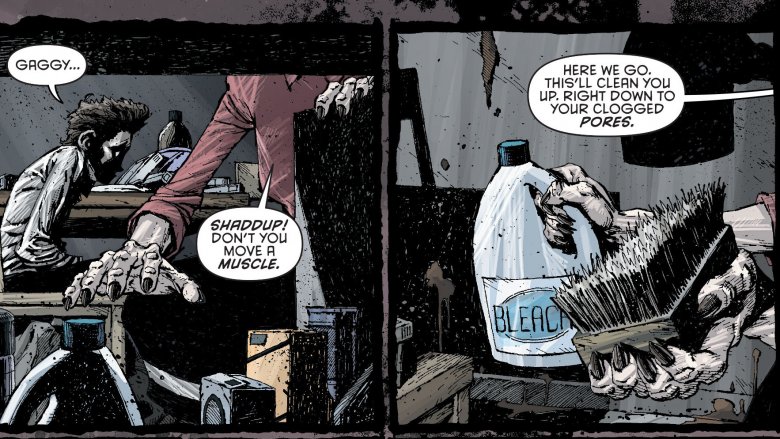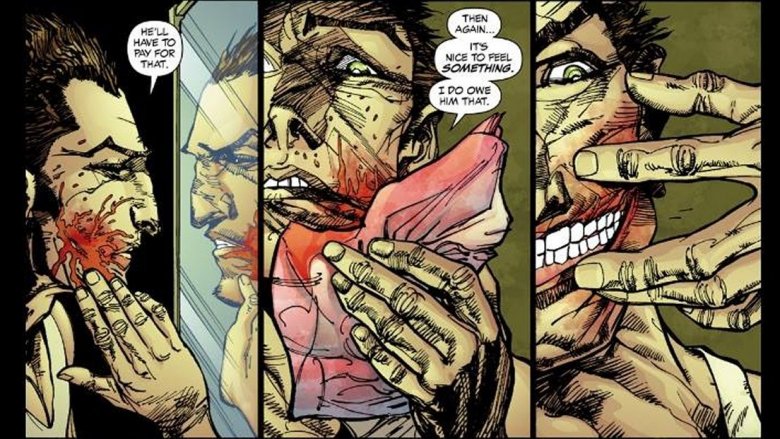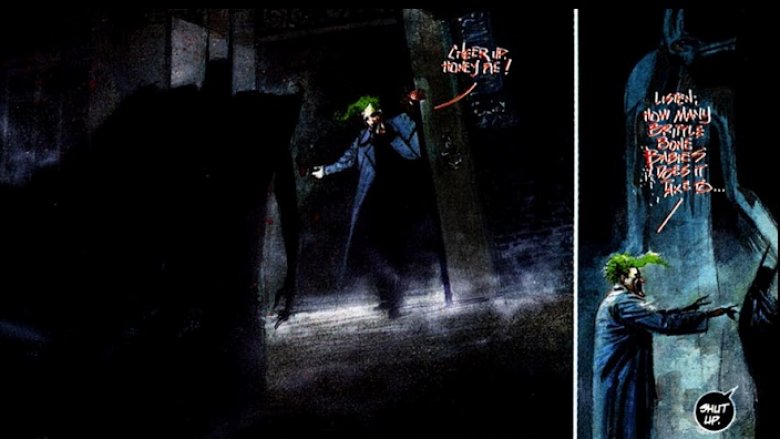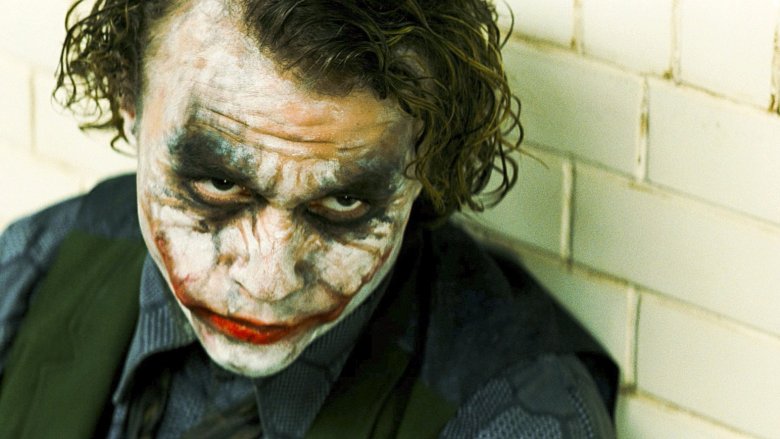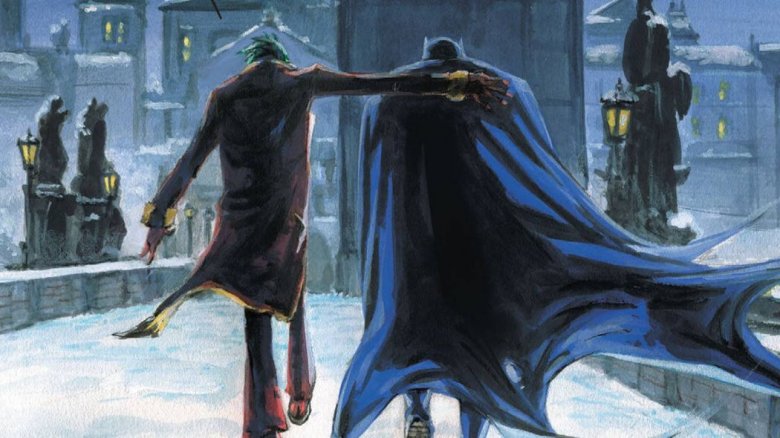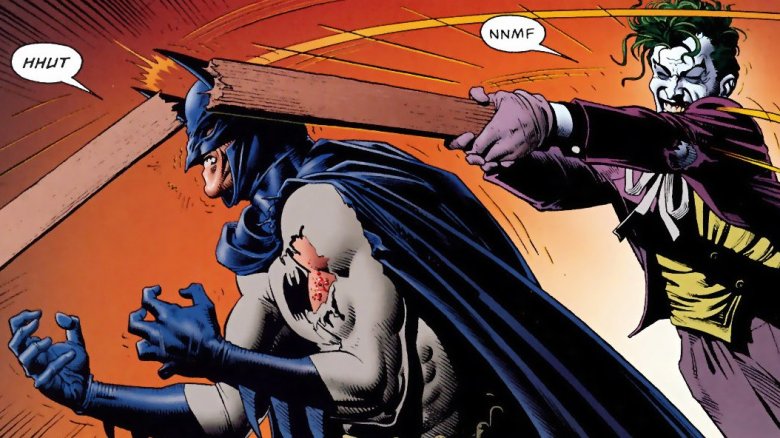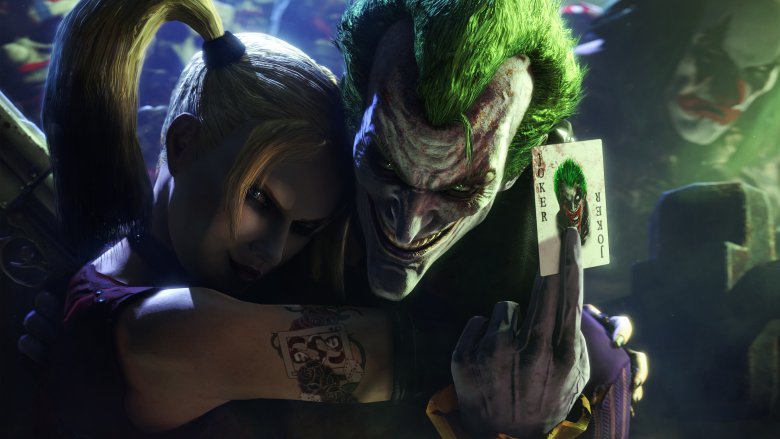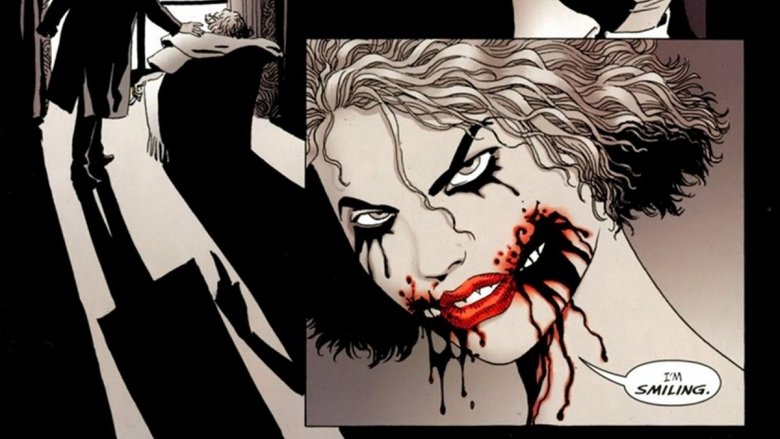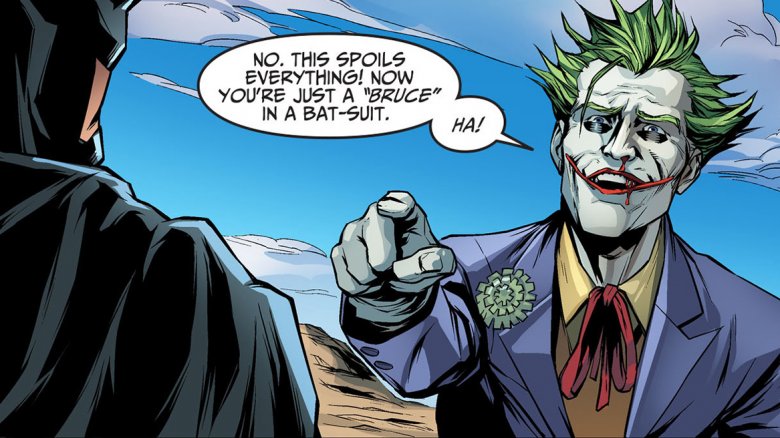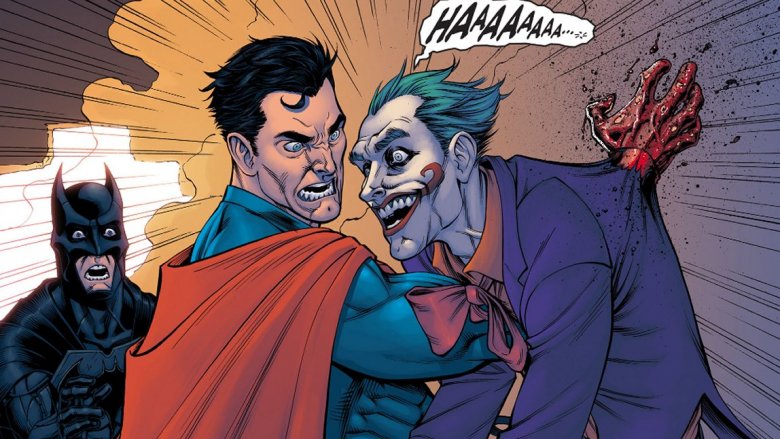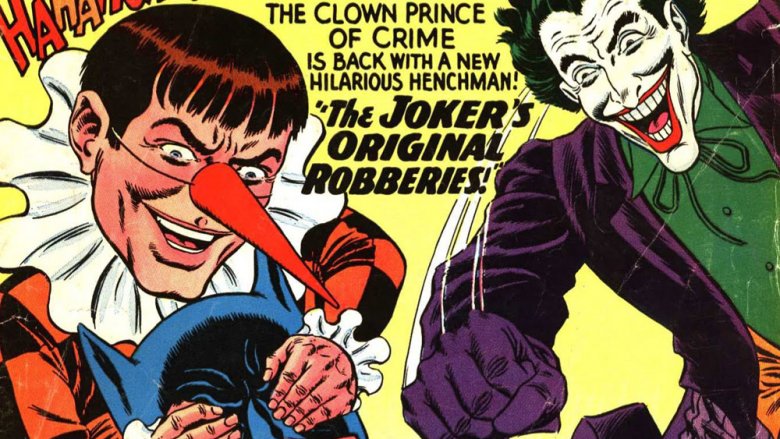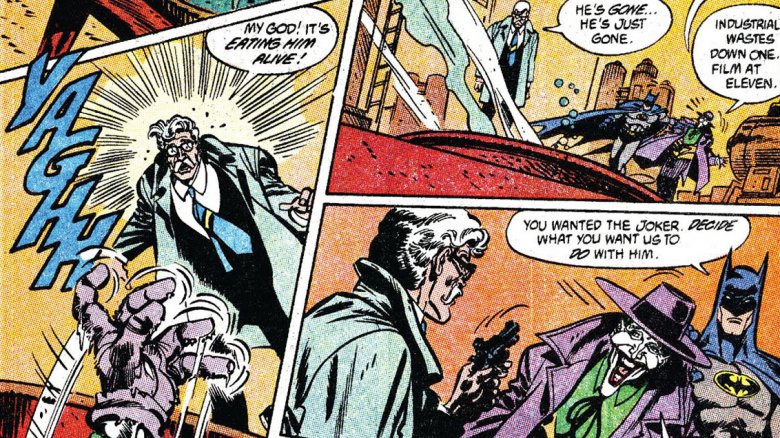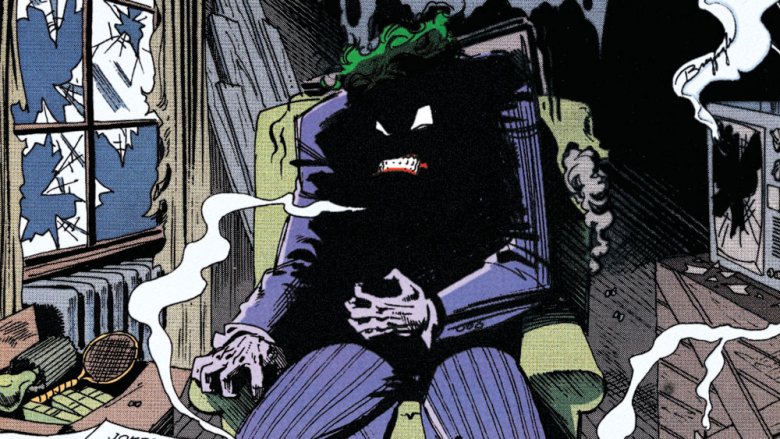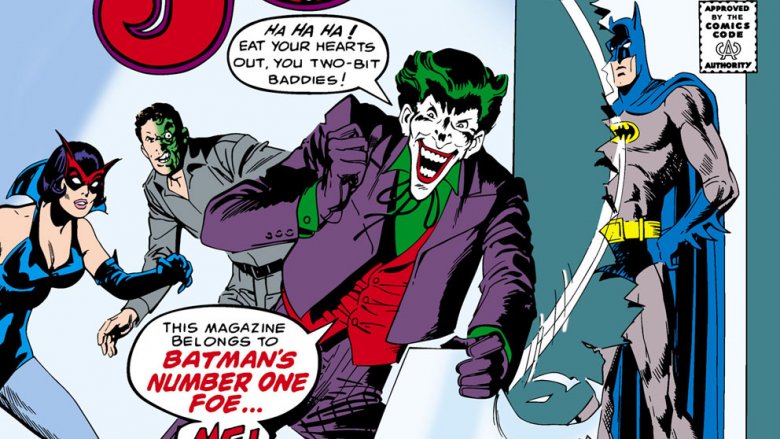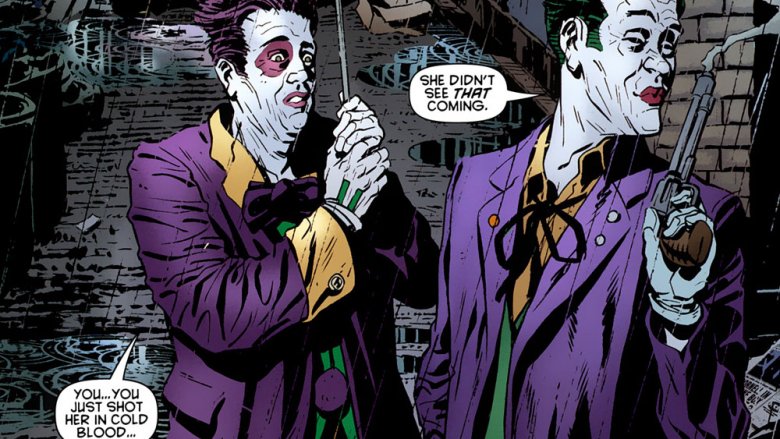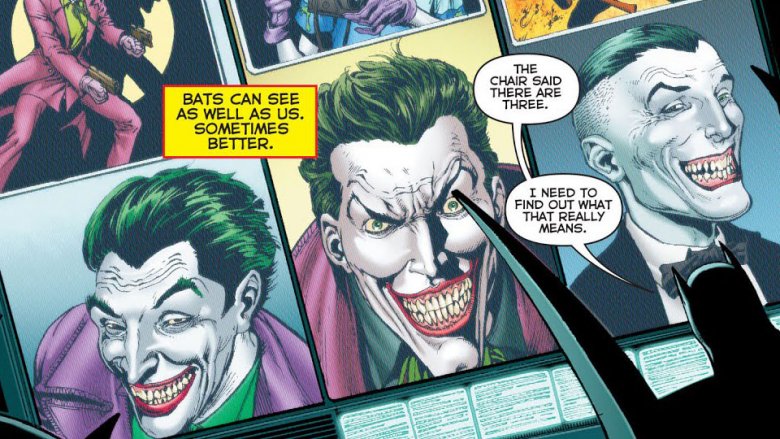False Facts About The Joker You Always Believed
When poisonous gas runs through the streets of Gotham City or the entire fish population floats to the surface with creepy red grins, everyone knows who to blame. The Joker is the most recognizable comic book supervillain of all time. Ever since Gotham's so-called "Dark Knight" first suited up, this killer clown has trailed carnage behind him, cementing a rivalry so iconic that it has been depicted in almost every Batman adaptation to date. However, while everyone knows the Joker is a disturbing guy, a lot of misconceptions have sprouted up over the years.
The Joker has a definitive origin story involving chemicals and a red hood
Most people think they know the Joker's origin: that he was a gangster called the Red Hood who one day ran afoul of Batman. Supposedly, this perp then slipped into a vat of toxic green gunk, and though he survived, the chemicals dyed his skin chalk white and stretched his mouth into a hideous, permanent grin. The classic narrative was enhanced by Alan Moore's The Killing Joke, which added such tragic details as a pregnant wife and a failed comedy career.
However, this entire origin story might have been fabricated by the Joker himself.
The Joker often tells contradictory stories of his past. This personality trait was adapted in The Dark Knight, where Ledger's character tells different people different stories about how he got his scars, either playing on their sympathy or trying to scare them. So while Joker has told the Red Hood tale to a few people, he's also told a different story to others, like claiming his white skin was caused by his abusive Aunt Eunice scrubbing him with bleach as a boy. Another story purports that his trademark smile has nothing to do with chemicals but was actually the result of Batman's batarang slicing his lips open. All these origin stories might be complete lies, and that's the point. As Polygon explains, the Joker is like a force of nature, so giving him a confirmed origin story would rob the character of his potency.
The Joker's name is Jack Napier
This falsehood has blown up like a bloated tick, and it's time to yank it out. No, Jack Napier is (most likely) not the Joker's real name. Gotham's scariest criminal has no confirmed origin, no identifiable fingerprints, no social security number — you know, "nothing in his pockets but knives and lint."
The name "Jack Napier" was created for Tim Burton's 1989 Batman blockbuster. Admittedly, it's a memorable name. Just like how Tony Danza always plays characters named Tony, Jack Nicholson is always at his best when he plays other Jacks. Meanwhile, the name "Napier" is actually a tribute to Alan Napier, the actor who played Alfred in the campy 1960s TV series. However, outside Burton's 1989 film, Jack Napier isn't the Joker's name. Though many subsequent stories have hinted at the name "Jack," just as many stories have used names like Joe Kerr or Oberon Sexton. The Jack Napier name did show up in Batman: The Animated Series, but according to the DC Multiverse Historian, it was written off as an alias.
It's worth noting that in 2017, writer Sean Gordon Murphy elected to use the Jack Napier identity for his comic book Batman: White Knight, marking the name's comic book debut. However, White Knight is not considered an official part of continuity.
The Joker is insane
The Joker commits a lot of bizarre, horrible actions, but to write him off as being "crazy" not only doesn't fit the character, but also trivializes real mental health issues, as noted by Today. Now, is the Joker narcissistic? Certainly. Dangerous? Yes. Emotionally unhealthy? Oh yeah. Sociopathic? Yeah, you certainly don't want to invite this guy to a dinner party. But in the comic book Arkham Asylum, by Grant Morrison and Dave McKean, Joker's own psychiatrist elaborates on the villain's condition, explaining that she doesn't believe he could necessarily even be classified as "insane." As reprinted in Dazed, the Joker is diagnosed with "some kind of super-sanity," wherein he has no control over the barrage of sensory perceptions surrounding him. Basically, he can't choose what he experiences: He experiences everything at all times. Unable to sort through the chaos, he instead copes by "going with the flow," meaning that every day, he recreates his entire personality based on his surroundings — sometimes as a "mischievous clown, others a psychopathic killer."
Even if the Joker isn't "crazy," he's still an immoral (and detestable) mass murderer. But he's responsible for his own horrific actions, and he fully understands the fact that he hurts people. According to How Stuff Works, the only reason Joker uses the insanity plea is because it allows him to skirt the death penalty.
The Joker role killed Heath Ledger
The Joker has always been a popular villain, but Heath Ledger's disturbing performance in The Dark Knight definitively reinvented the character for the 2000s. According to the Independent, Ledger's preparation for the part involved locking himself in a hotel room for a month and keeping a Joker diary full of dark musings. When Ledger tragically passed away from an accidental sedative overdose in the months leading up to the film's release, it led to the commonly accepted narrative that the actor's death was due to him feeling "haunted" by his own sinister performance.
Not so, according to the documentary I Am Heath Ledger. As written by the Telegraph, Ledger had struggled with insomnia for years, long before his Joker days. His sister, Kate Ledger, has directly spoken out against claims that the Joker role killed her brother, stating that he truly enjoyed diving into the role. She was "really shocked" by the widespread theories, saying, "He had an amazing sense of humor, and I guess maybe only his family and friends knew that, but he was having fun. He wasn't depressed about the Joker!"
As described by Variety, it's believed that his overuse of sedatives to combat insomnia may have actually begun after his breakup with Michelle Williams, with whom he had a daughter. By all accounts, his overdose was an accident.
Joker hates Batman
Batman definitely hates the Joker. How could he not? Not only is the so-called "Clown Prince of Crime" the antithesis of everything Batman stands for, but he's also made a habit of killing Bruce Wayne's loved ones. However, what makes their rivalry so interesting is that the Joker absolutely loves everything about Batman — or at least, the idea of Batman — arguably to a romantic degree. For example, How Stuff Works cites Batman #663, in which Joker says, "I could never kill you. Where would the act be without my straight man?"
In Frank Miller's The Dark Knight Returns, Batman hangs up his cape for a decade, and Joker is so depressed by the retirement of his "partner" that he falls into a nearly catatonic state. When Batman returns, Joker's life is given purpose again, and he goes on a new streak of mass murders. Notice the creepy thing, here? Joker's murders aren't done despite Batman's interference, but because he wants Batman's attention.
Joker's sexuality has often been a point of debate. Between his obsession with Batman and his seeming lack of sexual interest in Harley Quinn, Bleeding Cool points out that writers and artists have been hinting about Joker's sexuality and gender identity for decades. Also, as pointed out by The Root, the spoof movie Lego Batman turned this subtext into a major plot point.
Joker was created to be Batman's archenemy
The dynamic between Batman and the Joker is unbelievably perfect. Sure, bats never fight clowns, but the rest of it? Batman is a dark hero who creeps in the shadows, facing off against a bright, colorful villain who walks in broad daylight. Batman represents order, and Joker stands for chaos. Yet despite all their differences, the obsessive psychology of both men is scarily similar. With all these ingenious parallels, both characters must have been invented at the same time, right? It must have all been planned!
Wrong. At the beginning, Joker was never supposed to be Batman's archenemy. According to Comic Book Resources, the clown didn't show his face until 1940, about a year after Batman first debuted. Even more shockingly, the original plan was to kill off Joker after only two appearances, both within the same issue.
Bizarre as it might sound today, the villain was rescued by intervention from above. When the creative team drafted Joker dying from a knife wound in Batman #1, editor Whitney Ellsworth thought the character had too much potential to be written out. According to an interview with comics writer Steve Englehart on NPR, Ellsworth instructed the artist to insert an additional panel, depicting the villain being rescued by an ambulance. Considering how popular this killer clown has become in the decades since, it seems like Ellsworth made the right call.
Joker loves Harley Quinn
2016's Suicide Squad earned a lot of negative attention, including an abysmally low Rotten Tomatoes score. One of the most criticized aspects of the movie — both by fans and non-fans alike — was the uncomfortably romantic portrayal of the Joker/Harley Quinn relationship. As written by Samantha Rullo on Bustle, "to associate the word 'love' with the dynamic between Harley and Joker is to legitimize a toxic, abusive relationship founded on manipulation, shock therapy, and brain-altering chemicals."
The Joker doesn't care about Harley Quinn, which is part of what makes Harley's adoration for him so tragic. For one, Joker never shows any true romantic interest for anyone but Batman. Two, as depicted in the comics and the cartoons, the Joker is an abusive boyfriend who uses or ignores Harley for his own sick reasons. He's certainly possessive over her, particularly when she leaves him for Poison Ivy, but that's about control, not love. Furthermore, Joker has actively tried to murder Harley on numerous occasions, from trapping her in a rocket to handing her a bouquet of flowers stuffed with TNT. It's not a romantic relationship by any stretch of the imagination.
The Joker is always portrayed as a man
Though Joker is a character who regularly enjoys bending gender norms, he has usually been portrayed as a man. However, not every version of the character is male. In the popular Flashpoint storyline, Barry Allen (the Flash) rewrites history in an attempt to reverse his own childhood trauma. This action accidentally causes the whole timeline to go wonky, and one of the most shocking results of Barry's tampering is that Batman's origin is changed. Instead of Thomas and Martha Wayne being shot in Crime Alley, young Bruce bites the bullet for them. The boy's death rips the Wayne couple apart. Thomas is so driven to avenge his son's murder that he becomes a violent incarnation of Batman, and Martha ... well, she snaps, becoming the Joker. Creepy stuff.
The Martha Wayne Joker is every bit as sadistic and unhinged as the male version ever was. This twist also adds a disturbing new wrinkle to the Batman/Joker dynamic, with them being former lovers turned archenemies. Though every cinematic Joker so far has been played by a man, ComicBook.com points out that since WB is now developing a Flashpoint movie, Lauren Cohan (The Walking Dead) could very easily be the next person to don the infamous purple suit on film. Meanwhile in the comics, Screen Rant reports that in the 2017 comic Batman: White Knight, Harley Quinn becomes a new version of the Joker.
Joker doesn't know Batman's secret identity
Like two warlords feuding over the same turf, the conflict between Batman and the Joker is mostly a battle of competing philosophies. Neither of them seems to care much about their former "human" identities, since both have now become "more than just a man," as Ra's al Ghul might say. However, don't be fooled. Joker might not invade Wayne Manor every week, but he knows many secrets about the man behind the mask.
The Joker's knowledge of Batman's secret identity came to light in Scott Snyder's Endgame storyline, though it was hinted at several times before. In an interview with ComicBook.com, Snyder explained that before that point, Joker had always "pulled his punches" on Batman, knowing how easily he could destroy him. In another interview with Newsarama, Snyder elaborated, stating "Joker has decided to look at that thing that he has not wanted to look at, in hopes [that] Bruce would come over and be inhuman with him in some ways." Basically, Joker neither cares about nor wants to engage with Bruce Wayne's life: It's Batman he wants to play with.
Batman is his only superhero opponent
Most superheroes have a notable antagonist who defines their story, for better or worse. Superman will forever be tormented by Lex Luthor. Wonder Woman will always tangle with Ares. Spider-Man has to deal with both Doc Ock and the Green Goblin intruding into his personal life. Then we have Batman and the Joker, who are two sides of the same coin, and neither one of them ever seems complete without the other. However, just like Batman sometimes swings off and fights aliens with the Justice League, the Joker has been known to mess around with other superheroes as well.
Though Joker has sometimes gotten mixed up with heroes like Wonder Woman and Green Arrow, his most significant non-Batman rivalry is with Superman. As described by Kotaku, the relationship between these two foes took an especially dark turn in Injustice, an alternate reality storyline where the Joker tricks Superman into killing Lois Lane, resulting in the Man of Steel becoming so outraged that he literally drives his entire arm right through the Joker's chest, killing him instantly. While the story isn't part of continuity, the image is hard to forget.
Harley Quinn is the Joker's only sidekick
Since her debut on Batman: The Animated Series, Harley Quinn has grown into one of DC Comics' most popular characters, and as much a part of Joker's story as Robin is for Batman's. The two characters are downright inextricable, with Harley's ongoing saga being built around her struggle to break free from an abusive relationship taken to supervillain extremes. There's one aspect of the character that's not quite new, though: Harley Quinn isn't the Joker's first sidekick, and she's not the only one he's had by a long shot.
Most of these "sidekicks" are little more than one-shot henchmen that are only there so the Joker isn't talking out loud to himself all the time, but there are a few who have had bigger roles. Other than Harley, the most notable Joker affiliate is probably Gagsworth A. Gagsworthy, also known as Gaggy. He first appeared back in the '60s as a "refugee from a circus" who was hired by the Joker as a henchman and comic relief, and who helped out in fights with his glass-shattering laughter. For years, he only existed in Batman #186, but returned to comics in the 21st century as an enemy for Harley Quinn, fueled by his anger at being replaced.
Beyond Gaggy, Harley's other predecessors include Bob the Goon, the leader of the Joker's matching-jacketed henchmen in Tim Burton's 1989 Batman movie, and, of course, Jackanapes. That, if you don't know, was a super-intelligent gorilla that the Joker kidnapped form the zoo and raised as his own son, in a story from 2013. You might've believed some popular misconceptions about the Joker, but one thing that's always true is that he has some pretty weird interests.
Anyone could become the Joker
If you've only read one comic about the Joker, chances are pretty good that it was The Killing Joke, Alan Moore and Brian Bolland's critically acclaimed 1988 graphic novel that provided a possible origin for the character and saw him paralyzing Barbara Gordon with a gunshot to the spine. One of the big themes in that comic is the Joker's belief that everyone is just one bad day away from becoming someone like him. It's the debate at the center of the action, and while Batman might not have gone the murder-clown route, he definitely went to some strange extremes as a result of his worst day.
If you read that story and thought the Joker had a good point, though, there are a few other DC comics that might serve as a rebuttal. Sure, there are plenty of characters locked up in Arkham because they went through a pretty rough time, but actually becoming the Joker requires a few other ingredients. In 1990, Curtis Base found that one out the hard way.
Base was the star of a story that ran in Batman #450 and 451. It was actually the first Joker story after The Killing Joke and A Death in the Family, and featured Base taking advantage of the fact that everyone — including himself — thought the Joker was dead by committing some very ill-advised identity theft. He disguised himself as the Joker, and went about committing murders based on bad joke puns like choking someone on old chestnuts and literally pulling someone's leg ... all the way off. Eventually, the real Joker returned, but Base decided to complete his transformation by jumping into the same acid that the original emerged from with his signature look. Instead, he was dissolved to death in the vat. Clearly, the Joker has a little more going for him than just an acid bath and a bad day.
The Joker was always popular
It's tough to deny that the Joker was a hit from the very beginning. He's one of the few characters who made his first and second appearances in the same comic — Batman #1 features them both, broken up with Catwoman's first appearance. It's even harder to argue that the Joker isn't the most popular Batman villain, and probably the most popular villain in the entire superhero genre today. He's in the canon of the all-time great antagonists, and it's nearly impossible to imagine Batman comics without him.
With all that in mind, it's easy to think that the Clown Prince of Crime had that same amount of popularity for the 70-odd years in the middle, too. That's not actually the case, though. In fact, there was a time when the Joker's stock had fallen so low that there wasn't a new Joker story in the pages of Batman or Detective Comics for over four years. Today it's pretty rare for four months to go by without getting some kind of Joker appearance. Also, keep in mind back then, comics usually had three complete stories in every issue rather than a single story, built around a single villain, that ran for five or six months at a time.
As for why he was persona non grata for so long, there are a couple reasons. First, the years in question were 1969 to 1973, which coincided with the end of the Batman TV show. While the show had been a huge hit, the die-hard comics audience at the time was eager to get away from campy humor and back to more "serious" adventures. The Joker, as one of the more outlandish Arch-Criminals featured on the show, was closely identified with those goofy adventures.
Of course, there's another reason that has very little to do with the Joker's popularity — at least, among the fans. The Batman books were being edited at the time by Julius Schwartz, who had been brought on to revive the fading titles in 1964, and he just flat-out was not a fan of the character. That would explain both why his appearances were pretty sporadic in the '60s in general — and allegedly only fueled because he was so popular on the show — and why his few appearances between '69 and '73 happened in titles Schwartz was not editing, like Brave and the Bold and Justice League of America.
The Joker can carry his own story
The Joker's clashes with Batman and the other heroes of the DC Universe have made him a uniquely popular character in his own right, to the point where you might even call him "beloved" ... for certain values of love. With that in mind, isn't there enough interest in him as a character that he could carry his own stories without involving the Dark Knight? It worked for Catwoman, right? She's had multiple solo runs that have lasted for years!
Well, while there are clearly plenty of people at Warner Bros. who think he's a strong enough character to star in his own solo film, that hasn't historically been the case. DC attempted to capitalize on the Joker's resurgence in popularity back in 1975 with The Joker, a series that followed the Joker as he got into conflicts with other Bat-Villains and occasionally got one over on heroes like Green Arrow and a guy with a brain injury that made him think he was Sherlock Holmes. Perhaps unsurprisingly, it got the axe after only nine issues.
Between then and 2019, there's only been one other attempt at Joker sans Batman, a 2008 hardcover graphic novel with a version of the character who was close to (but not quite) the version that moviegoers had loved in The Dark Knight. That's it.
Joker is the DC Universe's only evil clown
Comic book characters live or die by their unique takes on the tropes and traditions of the genre. There are plenty of examples of analogue characters who have filed off the serial numbers of established heroes and villains and found their fame by adding a unique twist, but if you're just doing a story with a guy who's exactly like Spider-Man, you're really just reminding your potential readers that they could be reading about the real Spider-Man instead.
As a result, you'd think DC would be pretty reluctant to stock their universe with other clown-themed supervillains, especially since they once restructured their entire universe over worries that Supergirl and General Zod were diluting the brand of the Last Son of Krypton. It might be shocking to learn that they not only have other wicked clowns loitering around the DCU, but that they're actually canonical, in-universe knockoffs of the Joker.
Essentially, it was the villainous version of the way that they explored the idea that every country could have its own version of Batman through Batman Incorporated, showing the Joker as being such a purely influential concept that imitators would be attracted to him. In China, there's Alpaca, who showed up in the pages of New Super Man as a student who had been originally been trained by a government-sponsored program to create that country's take on Batman. Jarvis Poker, the British Joker (always referred to by the full title) was a much less deadly version who focused on pranks while fighting the Knight, until he was ultimately murdered by the genuine Joker. There's even a character called the Joker's Daughter who has showed up in multiple versions. She's not the Joker's actual daughter, though. She's Two-Face's daughter. Sometimes. Comics!
Okay, but there's only one real Joker
The Joker is a singular character, a one-of-a-kind antagonist whose lightning-in-bottle character development could never happen. That holds true in-universe, too. Surely there's no other character who could challenge the Batman like his one true arch-nemesis, who is destined to battle him forever in a test of wills!
Except that's apparently not how it works. Obviously, there are different takes on the Joker depending on the era and the creative team, something that was once explained away with the concept of "super-sanity" and the idea that the Joker is constantly reinventing himself. In 2016, however, the Justice League creative team of Geoff Johns and Jason Fabok took that idea to its literal extreme. When Batman briefly gained access to the entirety of knowledge for his entire universe, he asked what the Joker's "true name" was. He came away knowing that there are actually three Jokers out there doing clown crimes.
That was in 2016. In the years since, the whole thing about the Joker actually being three different people hasn't really been brought up in the comics. The company seems to be saving that for Johns and Fabok's upcoming and appropriately titled Batman: Three Jokers, but news about its release date and content is few and far between, aside form the occasional reminder that they're sticking with it, at least for now.
